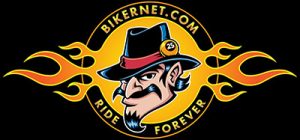
It’s a fascinating story of motorcycle love, business survival and toughness. But if you mentioned this to Larry, he would tell you to, “Fuck off.”
Every time I asked Larry to open up about the shop or this bike, he’d frown and tell me to read the tech chart he prepared.


I’ve known and worked with Larry off and on for 18 years. As a young man, he started his motorcycle career at Lomita Harley-Davidson from 1970-75. The dealer faced tumultuous times, and as a 20-something, Larry tried to take over the dealership. But he didn’t have the financial acumen to pull it off, so he opened Settle’s Custom Cycles down the street on 259th in the back of a single strip industrial group of shops. He’s been there mostly running the dank, lackluster shop solo for 45 years.


Lomita became California H-D in Harbor City and is still a couple of city blocks from Larry’s shop off Pacific Coast Highway.


He turned 70 about a month ago and some of the riders won’t go near his shop. “He’ll bite my head off,” one of them noted. After plenty of years running a small, hole-in-the-wall shop by himself, Larry’s patience grew thin. He needed to cut to the chase and see through bullshit or he was just burnin’ daylight. Occasionally, the boot-tough proprietor needed to point out the error of your ways, not mine. I’m cool.


Although Larry’s exterior has the scars of wars and bike accidents, he is way more than a grumpy thug. His heart and intelligence are profound. Just recently, he graduated from Long Beach State College. He helped a friend build a beautiful Puka Bar nightclub in Long Beach and struggled with it as long as he could.


Behind the scenes, he restores an old Harley from time to time and is currently working on a 1922 twin. He is also invested into building three complete Knuckles from the ground up. But he always wanted to build a Turbo bike.


This puppy started as a ground up in ’01. In ’04, he got a wrecked frame, modified it severely and moved the new ’01 Dyna engine he bought from Glendale H-D, the home of the Love Ride. At the time, it was a 95-inch Twin Cam with a 5-speed transmission and he rode the shit out of it for 14 years.


When he switched out the frame, he also installed a later, stronger swingarm but left the drivetrain alone. Then two years ago, a customer who tried to build a Jesse James bike gave up and sold Larry a new 2012, 103-inch Twin Cam and Larry went to work creating a Turbo bike.


For years, as he rode the Dyna constantly, he kept upgrading the suspension to prepare for a performance monster. Initially, he tossed around building his own turbo kit using Trask Turbo component. After working and quizzing the Trask team, he decided they did their homework. “Trask did such a beautiful job, I couldn’t improve on it,” Larry said.

I asked him about preparing a bike for this level of upgrade and he gave me that look. “Check the chart,” Larry said. “I covered all the elements.” He started by lowering the engine compression with 9 to 1 forged pistons and improving the heads with the help of Branch Flowmeterics and their titanium components. There are also the 60-spoke wheels for stronger road use.



He ran stiffer rubbermounts and upgraded the forks and rear suspension. A turbo motor is not only more powerful, but unlike stock engines it spins faster. “It runs like a raped ape,” Larry said. “I’m always fucking with it.”


But unlike most projects in Larry’s shop, this one stuck with him over 17 years. It’s not an investment to turn over or a customer project. This bike may stick with him for the long run. And don’t get me wrong. If you have an intelligent question or a project worthy of the master, don’t hesitate to stop by.
–Bandit


Engine
Model: 2012 103-inch
Flywheels: Balanced and welded
Left case: Timken bearing conversion
Pistons: Forged 9:1 compression
Heads: Branch O’Keefe rebuilt, ported and polished
Cams: H-D 255
Oil pump: High-volume
Cam plate: Billet
Pushrods: Adjustable
ECM: ThunderMax by Zippers
Turbo: Trask Engineering complete system

Frame
Year: 2004 Dyna
Stretch: 1.5 inch in backbone
Rake: 36 degrees
Modifications: by owner
Swingarm: 2010 H-D
Shocks: White Power adjustable reservoir

Forks
Type: Inverted forks
Suspension: XR1200X fully adjustable compression and rebounding


Fender brackets: Custom Made by Larry
Trees: Modified Buell

Model: H-D 2013 6-speed
Clutch: H-D slipper
Compensator: BDL
Clutch operation: BDL hydraulic actuator
Final drive: Chain w/ 51-tooth wheel sprocket

Paint
By: Chris Morrison Custom Paint
Color: Black with Silver striping

Art: by LRS

Wheels
Front
Size: 21/3 60-spoke wires



Size: 17/5 inch
Tire: 180/70/17
Caliper: FLT Brembo w/modified FLT bracket.

Electrical
Wiring: 2006 H-D Dyna Loom

Accessories
Handlebars: Modified T-Bars
Grips: Performance Machine

Sources:
Peformance Machine
Trask Turbos
Brembo Brakes
http://www.brembo.com/en
BDL
Branch
Zipper’s







